Sober Up People! Grasshopper Hill Mocktail & A POV on $SHOP, $AMZN, and $BIGC Q2 Results
Issue No. 13 - $AMZN, $SHOP, and $BIGC Release Q2 results this week. What can we learn and take away from them?
In today’s issue we sober up and look at the Shopify, Amazon, and BigCommerce Q2 earnings that came out this week - and what we can learn from them. But that is not going to keep us from mixing! This week we explore a great mocktail, spending some time in the kitchen and playing with some cool new, non-alcoholic mixology “tools”. I look forward to your comments and thoughts. Thanks for reading and I hope you enjoy! Cheers!
This Week’s Cocktail… um, Mocktail: The Grasshopper Hill
A confession and then a principal.
I will admit to being just a touch self-conscious only featuring cocktail after cocktail in this newsletter. I am not a lush! I am a mixologist! There is a difference!
Plus I want everyone to feel welcome at this party and that includes people who are not drinking alcohol - ever, this month, today, or just right now. Everyone should feel a part of the fun and not feel awkward or excluded from the laughter, and the exchange of stories and ideas that come from enjoying beverages and time together.
Truth is, my daughter has had a big role in my interest in mocktails. She has chosen not to drink, at least a vast majority of the time. So I dug into the topic a bit further, bought some books, and through making mocktails realized that what I really enjoy is mixing and drinking, not necessarily (always, at least) the buzz. In other words, we don’t have to get a big buzz on to enjoy mixing and drinking. And when the drinks are non-alcoholic, you don’t have to check yourself when you yell, “Who wants another round!?!”
And look, besides making everyone feel included - which is a good enough reason in itself - you have your head in the sand if you don’t realize that alcohol is not really great for us humans, especially in volume (let alone excess). Mocktails and shims - low-alcohol cocktails - allow someone who likes to mix like me a way to enjoy the craft while mixing up something healthy, or at least with very minimal downside effects. Most shims will end up with an alcohol content somewhere around a single glass of wine. Perfect before dinner, or in the afternoon, or whenever.
For those two reasons, I believe every mixologist should think about mocktails as well as cocktails, and toss in some low-ABV (shim) game as well.
ICYMI: I featured a great Billows & Thieves mocktail in Issue No. 3 for that reason, and of course have also explored Low-ABV cocktails as well in Issue No. 6.
A Visit to Grasshopper Hill.
This week we are featuring a bit of an original, as we reconstruct a roadside mocktail a good friend of mine raved to me about. He was driving with his family and they stopped on the way home for a bite. He wanted a cocktail, but had a long drive ahead, so instead ordered a mocktail off the menu. He absolutely loved it. Like many finely crafted mocktails it can give you the pleasure of drinking a cocktail, without the inebriation.
The drink on the menu was called the Chapultepec. I presume that is after the legendary park and neighborhood in Mexico City that is centered on a rock formation called Chapultepec Hill or Grasshopper Hill - a landmark since the pre-Columbian era when it was a retreat for Aztec rulers. In the Spanish colonial period, Chapultepec Castle was built here, eventually becoming the official residence of Mexico's heads of state - but not before the castle was the site of a major battle in 1847 between American forces and Mexican forces holding the strategic location during the Mexican-American War. It is now the site of Mexico’s National Museum of History. I hope to visit there someday.
My friend sent me the picture of the menu below. Looking at the cocktail - - we both noticed some interesting ingredients - pineapple tepache, tamarind, lemon, orange, Tapatio (hot sauce), ginger beer, and Tajin. We talked about it and thought, let’s try to recreate this puppy.
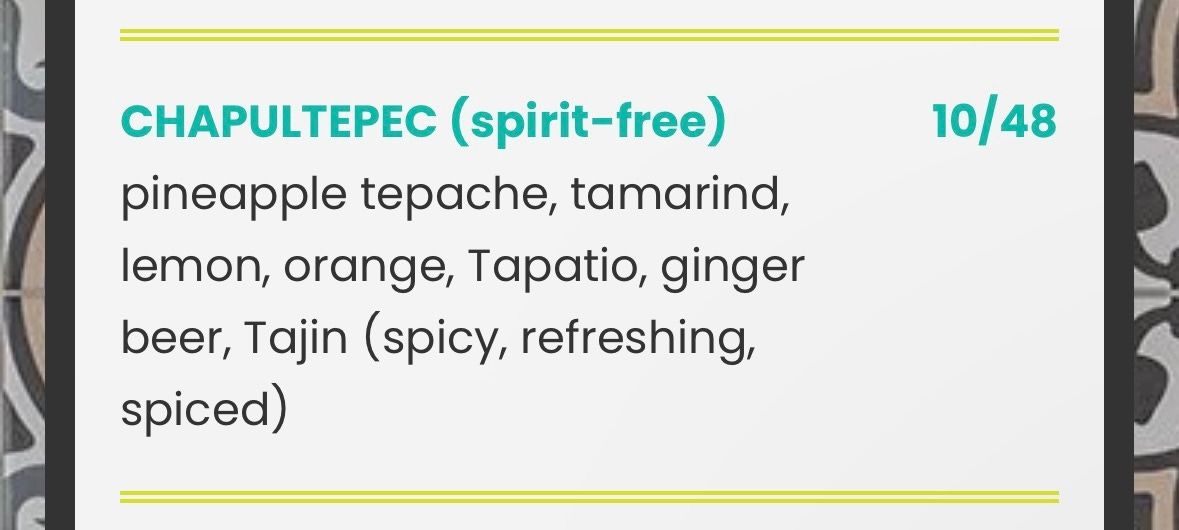
I had never made tepache before. Tepache for those unfamiliar is a fermented beverage made from the peel and the rind of pineapples, and is sweetened either with piloncillo or brown sugar, seasoned with powdered cinnamon, and served cold. In Mexico it is common for tepache to be spiked with a small amount of beer as well, though of course here that is replaced by ginger beer. When I looked into it, I found that the process is very simple, and so I went for it. Total time to get the process going by washing and cutting the Pineapple, and then adding sugar, water and some spices? Ten minutes. From there, monitor and stir the jar every 24 hours for a couple of days. We can do this people! Work ahead! You do that everyday!
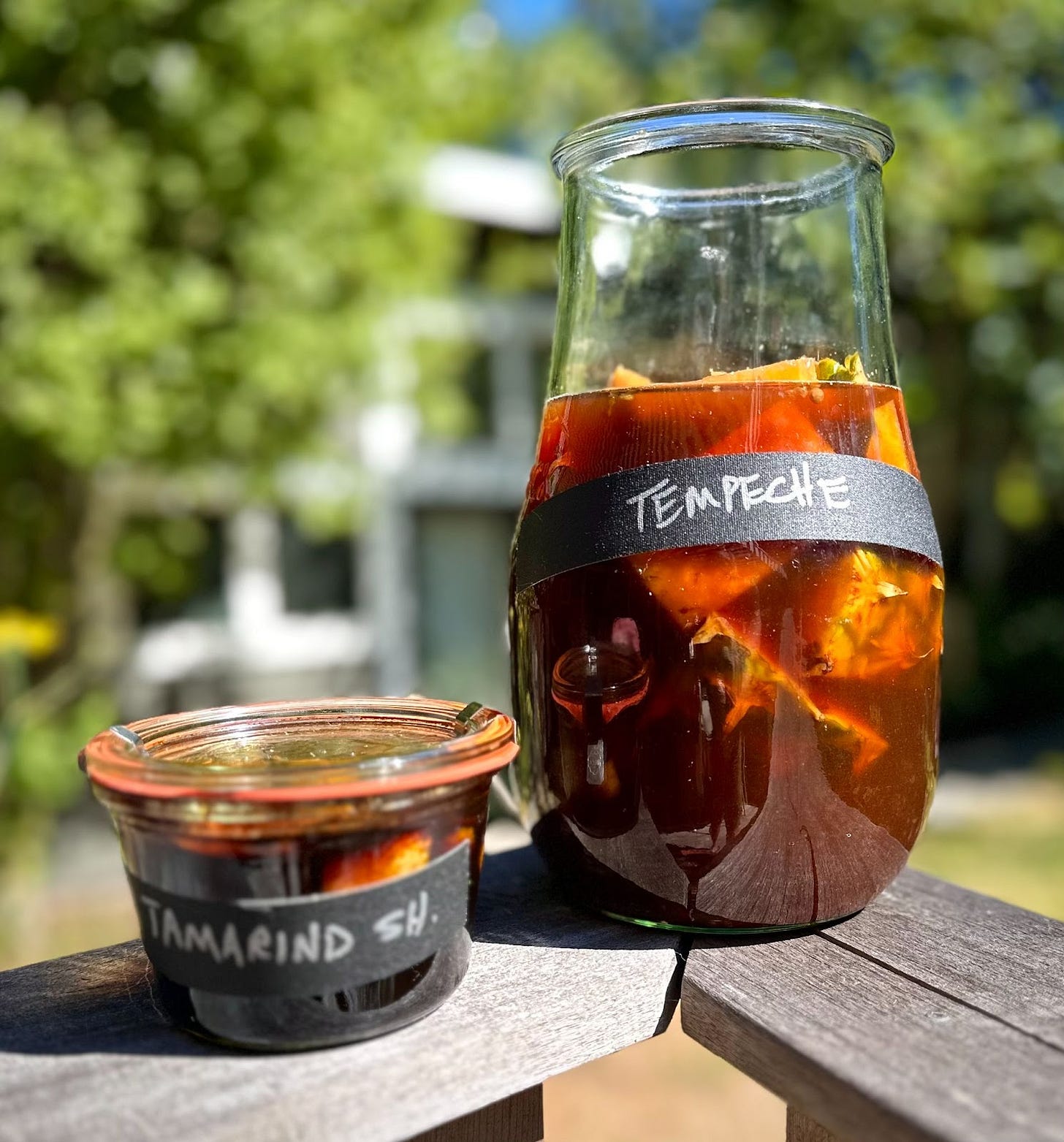
Next up on the ingredients list is a set of components that we decided would be good for a shrub or syrup - the tamarind, orange, and lemon. I ended up making something somewhat in-between a shrub and syrup - I wanted to be careful with the vinegar. (I include my approach below). Technically a shrub is an acidified syrup, but most shrubs are going to be much closer to drinking vinegar than the syrup I did here, so let’s call it a ‘shrubby-syrup’. Total time to make the shrubby-syrup, ten minutes. Boom.
Tapatio, it comes out of a bottle. Boom.
Ginger beer, well, you could certainly make your own, but there are also really good ones available commercially, and they come in a bottle - like Fever Tree’s. Boom.
I ended up making about four or five variations on the spec - that my wife and I taste-tested - and fine tuned from there to what you see below. I went with one right in the middle of the five I made. I found it had a rich flavor, where I felt I could taste everything, and where I felt the drink balances. But you could easily do something on the lighter side than what I ended up with - those versions were great too.
This mocktail is delicious, refreshing, and spicy! Perfect for a hot summer afternoon or evening. In fact, it would be great for brunch too. How about another boom? Boom!
A lesson here about mocktails.
Some complain that mocktails require a lot of prep, and to some degree that is true - but there is a reason. When you pull in a spirit, a vermouth, an amaro, bitters, or a liqueur into a cocktail, you are working with ingredients that already have complex flavor profiles. Mixing them together to create something with both balance and complexity then becomes the key skill. With a mocktail, that prep work is doing the same thing. You are macerating and cooking elements to create more complex flavors you will then combine - often much more interesting than the raw flavor of a juice, for example.
Those complexities do not come for free. All the NA spirits and modifiers hitting the market - which is great to see - are all just creating shortcuts to get to that place. But as with all short-cuts, they may not lead you to the best views and experiences. Sometimes it is better to take the time and go on the journey that takes a little more time - or in this case, some advance work. Advance work that in the end takes very little real time.
Cheers!
Grasshopper Hill Mocktail spec, serves one:
3 oz (~90 ml) - Tepache (see note)
1 oz (~30 ml) - Tamarind/Orange shrubby-syrub (see note)
1 barspoon (~5 ml) - Tapatio hot sauce
1 dash - Infuse Tres Amigos bitters (substitute 1 dash Tabasco, yes the bitters are spicy hot!)
To fill - Ginger Beer (Fever Tree Ginger Beer recommended)
Garnishes: Sprinkle of Taijin Classico, and slice of raw ginger and ancho chile on a skewer if desired
The process:
Combine all ingredients except Ginger Beer in a cocktail shaker, add ice. Shake until well chilled. Strain into a highball or tall glass filled with crushed ice (cubes are fine if needed) and pour Ginger Beer down a bar spoon top the glass, garnish with Taijin and ginger.
Notes:
I linked to the Tepache recipe above, but here it is again, from Live Eat Learn. Again, very easy and quick to do. And Tepache has lots of possibilities, including adding different fruits and spices. Exciting!
My Tamarind/Orange shrubby-syrup:
Ingredients:
2 oz. Tamarind paste,
peel of one orange,
peel of one lemon,
1 cup of sugar
.5 cup of room temperature water
1 tablespoon apple cider vinegar
Process: combine all ingredients in a saucepan and bring to a near boil as you stir, remove from heat, refrigerate in sealed container. Will keep for up to one week (though I sometimes will stretch it, or add 1 tablespoon vodka or everclear to help preserve for longer.)
Pouring your carbonated water or tonic down a bar-spoon is a great trick to preserve the carbonation and combine the drink without a lot of stirring. It is also fun and your guests will be impressed! I took a photo to illustrate, though I could not pour while taking it and my wife was off in her painting studio, so this will have to do:
Later on into the evening I made another of these and tossed in 2 oz. of decent aged rum - I used the good and affordable Diplomatico Mantuano. It was fantastic! Shrubs were originally created to pair with rum and brandy, so that makes sense. And what goes better with pineapple than Rum! Mezcal would also be fun to try here in my view.
Analysis: Shopify, Amazon, and BigCommerce all released Q2 earnings this week. What can we take away from them?
With this analysis I am looking less at these companies from an investor perspective than I am from an industry perspective. I am focused on what insights we can infer on the health of the commerce tech and e-commerce markets overall - and what the outlook is moving forward. I am not a stock analyst and nothing here should be construed for investment advice, even if I haven’t been drinking (see above mocktail).
Shopify
Shopify is now a seventeen year old, flaunting itself as an attractive, eager young adult full of confidence, flexing in the mirror and admiring its own sex appeal. Their Q2 results and recent announcements make clear there is something to that. But are they really ready to mix with the enterprise commerce coeds when they get to college soon?
Shopify reported strong Q2 results overall. Shopify’s total revenue increased 31% YoY to $1.7 billion compared to 2022. Merchant Solutions revenue was up 35% to $1.3 billion compared to the prior year, driven primarily by the growth in overall of GMV put through the platform by merchants, which increased to a total of $55.0 billion, an increase of $8.2 billion over Q2 2022 (on a constant currency basis GMV was +18%).
The core of Shopify’s business in many ways is payments, backed by their relationship with Stripe. Gross Payments Volume for Shopify grew to $31.7 billion in Q2, representing 58% of all GMV processed through Shopify, versus $24.9 billion, or 53%, for the second quarter of 2022.
Shopify’s subscription revenue also increased 21% to $444 million compared to the prior year. Shopify shared that this was primarily due to more merchants joining the platform and the pricing changes that went into effect for existing merchants in April 2023.
However, not all the news was positive. While gross profit grew 27% YoY to $835 million, Gross margin for the quarter fell to 49.3% compared to 50.7% in Q2 2022. This was driven by a higher mix of revenue from Shopify’s lower margin Merchant Solutions segment and lower margin revenue contributions from Deliverr, which Shopify announced they were selling to Flexport and Ocado in May.
As a result, Shopify’s operating loss was $1.6 billion, but those did include one-time charges related to the sale of the logistics business, as well as stock and reorganization costs related to laying off a whopping 20% of its workforce - one out of five people is a lot, and this was the second mass layoff Shopify had in less than a year. They juiced the margins with the layoffs, and still came up short. And those lower margins certainly explain that decision to exit the logistics business within a year of getting in.
My key takeaways from the earnings call, release, and recent Summer Edition product announcements:
Shopify GMV is outgrowing overall e-commerce growth rates. The U.S. Census Bureau's reported advanced monthly e-commerce (non-store) retail sales in June grew +9.9% YoY, accelerating from +9.3% YoY in May and +5.3% in April. June retail sales overall was relatively flat at +0.6% y/y after accelerating 2.3% in May, which of course means all growth in retail in the U.S. is coming from e-commerce. With Shopify’s GMV volume increasing 17% YoY, the merchants on and added to the Shopify platform are growing their sales nearly twice as fast. From that we can infer that the SMB e-commerce segment - though down from the crazy pandemic acceleration - is doing well overall.
Some solid Enterprise wins announced. Shopify announced a bunch of well-known brands, including Soft Surroundings, Jafra Cosmetics, Hunter, Meta, Dollar Shave Club, New York & Company, Mrs. Fields, Nina Ricci, New Era, Nestle, and Unilever. Interestingly these are all enterprise segment customers - which makes sense given the audience for these releases - but that is not the segment that is actually accelerating. That said, these were competitive wins.
Reconfigured Go-to-Market focuses on segments. On the earnings call, Shopify President Harley Finkelstien spoke about Shopify's revamped sales and marketing approach - an end-to-end sales process tailored to various merchant segments - as a win for operational efficiency and higher cross-sell. This move clearly makes sense, though the enterprise segment continues to suffer from leadership churn and lack of investment. On again, off again, enterprise focus has eroded Shopify’s momentum in this segment over the last two years and in my opinion continues to do so.
Shopify is being smart about AI. During Shopify’s Summer '23 Edition launch, they featured a number of capabilities under ‘Shopify Magic - their brand for a suite of AI-enabled features integrated across the Shopify platform to make it easier for merchants to run their businesses. Think templates, design, analytics, and navigating the how-to of setting up promotions and merchandising rules. I like the focus on merchants who are all busy and multitasking and can use a smart AI-enabled assistant to help them find and execute opportunities. It is early, but the direction is strong. They are ahead of many other commerce platforms at this (early) stage of blending useful AI into their platform.
Shopify Collective represents a meaningful new marketplace capability. The company launched the Shopify Collective in Q2, allowing retailers to sell products from other Shopify brands via a type of marketplace model, dovetailing their B2B initiatives. This is a nice opportunity for Shopify’s smaller merchants as well as those selling commodities within the ecosystem. I expect this will become a major revenue driver for Shopify, driving GMV and thus other metrics - but as with all marketplaces the devil will be in the execution details. With Shopify relying on partners here - and an order-management and customer service systems geared to SMB - this could be challenging to execute.
B2B wholesale is gaining traction for Shopify, but is SMB focused. This is most valuable and important for Shopify’s many small brands who in addition to selling DTC through Shopify, need a simple bulk and B2B web-presence. Shopify is making traction here, with B2B GMV was up 61% in the first half of 2023. The Summer Edition product release focused a lot on B2B, with over 45 new customizable features designed for wholesale businesses. Do not expect this to support mid-market or enterprise anytime soon, and is rightfully geared at CPG brands for now.
Progress with headless. Shopify reported that their React-based headless toolkit - dubbed Hydrogen - hit the $1 billion cumulative GMV mark, with 2023 GMV already twice as much as they totalled 2022. That is of course a big number, but they reported GMV. Assuming all those merchants are on the larger side for Shopify’s customer base, that puts them at somewhere between 100-300 merchants running that solution. Still meaningful, but not necessarily a big success thus far.
Offline momentum is still underwhelming. Shopify’s offline, point-of sale (POS) GMV increased 23% YoY, driven by investment in their point-of-sale platform and a focus on larger multi-location merchants. Shopify reported their Q2 GMV for retailers with more than 20 locations grew over 120% YoY. Solid momentum, though anecdotal evidence suggests that Shopify has more work to do here as many of these merchants complain about missing features and capabilities, as well integrations that are important to linking the online and offline channels - such as inventory management. If Shopify really wants to be an omnichannel commerce solution provider, there is a lot of work to do.
Connected to offline - Shop Pay Installments for in-store. Shopify reported that the introduction of Shop Pay Installments into point-of-sale solutions for their POS customers resulted in a 5x increase in retail average order value. No doubt this is a welcome solution for Shopify’s apparel and aspirational luxury merchants, providing flexibility in payment options for their customers. It is of course a slippery slope in the age of expensive credit.
The Swifty Bump. Shopify managed to score some high-profile collaborations with celebs like Taylor Swift and Drake. In July, Taylor Swift launched her Eras Tour merch shop on Shopify. That same week, Drake released his new store, Drake Related, using Shopify Collective. And finally, the YouTube phenomenon known as Mr. Beast, revamped his store using one of Shopify's out-of-the-box free themes for his SMB store. The Swifty volume alone this summer has to have driven some meaningful GMV, and these types of collaborations are hard for others to compete with - providing Shopify a marketing and brand awareness bump none others in this market can compete with.
I’m guessing when Shopify shows up to the rush parties at college next year, there will be more than a few coeds turning their heads.
Amazon
By contrast to Shopify’s teenage hormonal peak, Amazon is about to turn thirty. Amazon is holding down a good job, living in a good neighborhood, belongs to more than one wine club, is raising a few kids, and has a new puppy. But don’t let appearances fool you, after everyone is in bed Amazon is back online looking for psilocybin docents and black market HGH. Time for a reboot!
In my opinion, Amazon’s Q2 earnings completely reinforce the critique I made in Issue No. 3: Tainted Love Cocktail & Have We Reached Peak Amazon.com? - Amazon’s degraded e-commerce customer experience and merchant relationships are impacting the retail business, AWS is holding court but finding the cloud provider tournament is getting more challenging, and is now addicted to the crack cocaine of the ad business - their retail media business. Check out that earlier post for a more thorough examination of the traps Amazon has set for themselves - plus that Tainted Love Cocktail I featured is KILLER!
That said, the results on paper were good for Amazon. Amazon reported $134.4 billion in Q2 revenue, up 11% YoY. Net income came in at $6.7 billion. Operating income came in at $7.7 billion, up from $3.3 billion in Q2 2022 and well above the high end of Wall Street analyst “expectations” and the company’s earlier guidance. Big win for the focus on cost and optimization at Cadabra these days, as they handily beat Wall Street’s expectations, with net the income of 65 cents per share, nearly doubling the forecasts.
And all the investor dudes and dudettes out there? They abide - shares were up more than 7% in after-hours trading after the release. (Let’s just all agree here and now that “The Big Lebowski” is a Top-5 movie all time. Cool. I knew that you would.)
Some key takeaways from Amazon’s Q2 Earnings:
Amazon’s retail business is essentially flat. Amazon’s online retail revenue was up 4% year-over-year at $52.9 billion. As I mentioned above, the U.S. Census Bureau's reported advanced monthly e-commerce (non-store) retail sales grew +9.9% YoY in June, accelerating from +9.3% YoY in May and +5.3% in April. Amazon meanwhile only grew 4%. That is barely keeping up with inflation and means Amazon is losing share in the e-commerce market. In fact, Amazon’s physical stores segment - which includes Whole Foods and Amazon Go stores - even posted higher revenue growth than the online segment - up 6% YoY with revenue of $5 billion, and for the first time in Amazon’s history, online store sales represented less than 40% of its overall net sales in its Q2 results.
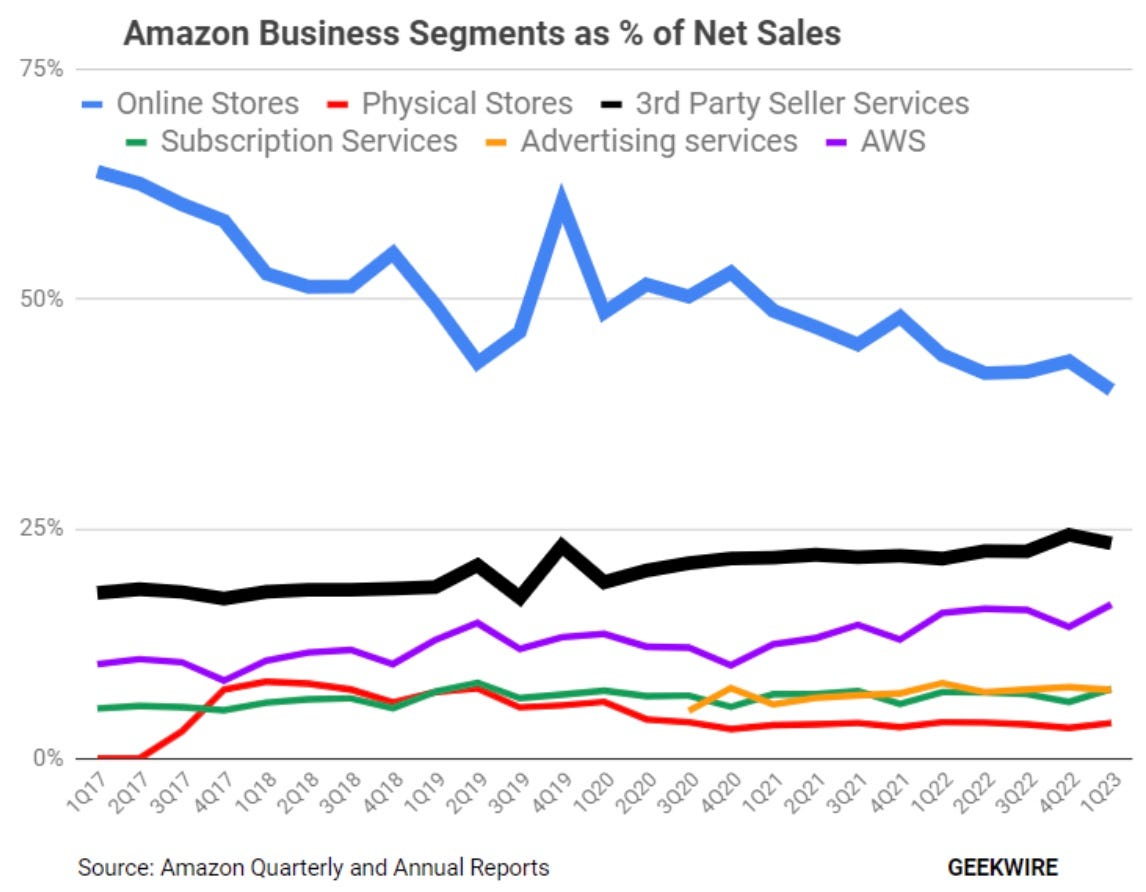
Big (marketplace) wheel keep on turnin'. Revenue from third-party seller services was up 18% to $32.3 billion in Q2, accounting for 60% of all units sold, a new record. Amazon increasingly makes money on both sides of these relationships and the experience for merchants has also eroded - feeling nickel-and-dimed in the process - as has the customer experience.
Amazon was quick to pump up to volume. Amazon claims it delivered its largest selection of products to U.S. Prime members at the fastest speeds ever during the quarter. Amazon reported that so far this year, Amazon has delivered more than 1.8 billion units to U.S. Prime members the same or next day—nearly four times the number of units delivered at those speeds by this point in 2019. If there is one area Amazon has proven over and again that they are great in, it is logistics and fulfillment. Amazon trumped a record Prime Day in July, but the impact of that will be felt in the Q3 results.
Amazon’s B2B business is now a $35 billion business. Amazon shared that Amazon Business is one of our fastest growing offerings, with a $35 billion annualized gross sales run rate and serving more than 6 million customers. Amazon Business allows businesses, municipalities, and organizations to procure products like office supplies and other bulk items easily and at discounted prices.
Having a hard time managing their crack habit, Amazon’s Ad business continues to grow. Advertising is one of Amazon’s higher-margin businesses, and it brought in $10.6 billion in Q2, up 22% over a year ago. That’s comparable to the 23% growth rate in Q1. By contrast, Google’s ad revenue rose just 3.2% in the second quarter and Facebook’s rose 12%. The problem is that chasing growth here will come at further costs to the retail business and overall experience consumers have with Amazon. It is worth noting that Wall Street analysts are also flashing warning signs about the degradation of Amazon’s retail customer experience, though they have been focused on the cost cutting, and less savvy to the impact the ad business is having.
Prime, it’s more than just a steak, um - I mean, a Subscription. Subscription services revenue, which includes Prime memberships, came in at $9.8 billion, up 14%. This is of course where the video streaming and other content services live. Amazon may also benefit from the slow down in new U.S. streaming content production from the SAG-AFTRA and WAG strikes - as is Netflix - instead using foreign content and production.
Amazon is primed (pun-intended) to look a bit more fit when it hits the late summer parties - the diet, the exercise, and mocktails are having an effect. But they are still yet to find their new purpose in life as they near thirty. Maybe the psilocybin sessions can help Amazon get in touch with it’s true self.
BigCommerce
If Shopify is the sexy seventeen year old, and Amazon is the twenty-nine year old trying to find themselves, what does that make BigCommerce? BigCommerce was founded in Sydney way back in 2009, but went through a major reboot - so I am going to discount the age and see them as a puberty riddled teen torn between playing with their old toys (SMB) and trying to hang out with the cool kids (Enterprise).
BigCommerce’s Q2 Earnings were very well received. The stock has had a tough run, hitting its 52-week low on May 12, and down 34% in the past 12 months. But shares were up 26% after the company reported a second-quarter loss that was narrower than expected. BigCommerce’s total revenue was $75.4 million in Q2, up a modest 11% YoY, with an annual revenue run-rate (ARR) of $331.1 million. Subscription revenue was $56.1 million, up 10%.
Some key takeaways from the BigCommerce Q2 earnings release:
BigCommerce’s focus on the enterprise segment remains a work in progress. BigCommerce defines enterprise accounts as those over $20 million in annual revenue - which is much lower total revenue than most in this industry and many of these customers would classify as mid-market in most competitors’ segmentations. That said, ARR from Enterprise Accounts as a percent of total ARR at BigCommerce was just 71% at the end of Q2, compared to 70% as of June 30, 2022. The number of enterprise accounts was up even less, at just 9% YoY, with 5,929 accounts. BigCommerce CFO Daniel Lentz, even highlighted the SMB segment as a key strength in the quarter, stating, “The performance of the small business portion of our business has exceeded our expectations, and revenue and operating loss results have exceeded guidance. We continue to optimize for profitable growth in the mid-market and enterprise portions of our business as well.”
BigCommerce - like everyone else - is climbing on the AI train. In July, BigCommerce announced it will add new AI-powered features to its platform, leveraging and embedding the AI capabilities from Google Cloud. The new features will focus on helping clients drive operational efficiencies, elevate customer experiences, enhance product discovery and drive sales - in other words conversion and AOS. This will have implications on the ecosystem as everyone vies for leveraging AI and overlapping capabilities make partnering more challenging. BigCommerce announced these features will be available to enterprise clients by the end of 2023.
Upsell in the enterprise segment is lagging. The average revenue per account of BigCommerce’s enterprise accounts was $39,870 - up just 5% YoY. Given inflation and the Feedonomics acquisition and cross-sell opportunities, this needs focus and improvement in order to make acquisition math work. BigCommerce is projecting 2023 annual revenue of between $304.0 million and $310.0 million, a growth rate of between 9% and 11%. Fixing the up-sell/cross-sell motion is the best way for BigCommerce to juice these numbers given the slower replacement cycles in the commerce platform market.
BigCommerce is demonstrating discipline. With GAAP margins coming in at a healthy 75%, same as last-year, BigCommerce is showing it has a plan to grow while maintaining cost and operational efficiency. That is good, but it takes marketing, channel, and effective salespeople to make that enterprise motion work, and a conservative approach will not yield the results BigCommerce is hoping for.
I’m personally rooting for BigCommerce to hit their stride and make the mid-market (or what they call enterprise) platform market more competitive. And Brent, if you happen to read this, my thoughts are with you and your family (for other, more important reasons.)
In summary as we look across these three companies results we can gather that e-commerce growth is clearly happening more in the SMB segment, as seen in Shopify and BigCommerce results. Meanwhile Amazon is losing overall e-commerce market share and falling deeper into its traps. Shopify’s momentum in notable, though having still a relatively modest impact on the enterprise market. Similarly, BigCommerce is struggling to hit its stride in the enterprise segment. And AI? It’s everywhere, man. (In my head, it was The Dude saying that.)
Bonus Culture Content:
“The Lexicon of Grunge” & When the New York Times was duped

My prime party years spanned the mid-80's to mid-90’s, and grew up and went to college primarily up in Seattle. That put me close to ground zero for grunge. There are a lot of misconceptions out there. For example, in Seattle we really did not talk about grunge as a thing, we just focused on good, interesting music. Seattle was in a bubble then - still very provincial and inexpensive - and was a haven for all kinds of creativity. Me? Oh no, I was not a musician but did occasionally play the part of band manager when my friends in a band needed to seem like they had a “money guy”.
In Seattle then, bands formed, broke up, formed new bands and musicians worked on each other's projects. Best off, it felt as if the entire music community was rooting for each other. When grunge suddenly went global, to be honest, we were confused. Don’t get me wrong, some great bands went huge, but a lot of others were left wondering if they would get a deal - except they were not grunge.
This week, I spent a good chunk of time listening to my favorite radio station - Seattle’s legendary KEXP, now streamed around the world and with a great app. This is a real radio station with amazing, knowledgeable DJ’s - this week for example they did 168 straight hours linking every song intentionally to the last, which turned into ‘Six Degrees of Sub Pop’, which naturally touched on early grunge and a bunch of other great stuff that Seattle label has released over the years. It was an example of how human curation can lead to new associations and of course, all the great stories of how music and the music industry are interconnected. They crossed almost every genre. Amazing. (PSA! DON’T LET THE ROBOTS TAKE OVER!)
During one air break they started talking about this great story having to do with the “Lexicon of Grunge”. The story of how Megan Jasper, a sales representative for Sub Pop Records was interviewed by a reporter from the NY Times in 1992 and made up a set slang term definitions on the fly, assuming he was in on the joke. Instead, he published them. This is a hilarious story. Someone should make a movie. Think about the soundtrack!
And check out this video as well, which may explain why I shrug my shoulders when someone asks me about growing up in the time of grunge in Seattle.
Join me and meet at these upcoming events:
Events and conferences are entering the summer hiatus, but there is one more important one to have on your radar:
Bloomreach Edge Summit - Napa Valley - August 24-25, 2023. Join us in beautiful Napa Valley, CA to explore the impact Generative-AI will have on digital commerce and marketing. Get educated, discover key use-cases, and have a POV on the impact on your business and clients. If you can’t make the physical event, join us for the digital livestream.
If you are looking for me online, you can find me here, here, and here.
And remember: "Yeah, well, you know, that's just, like, your opinion, man." - The Dude, The Big Lebowski
Be well, be safe, and here is to good business! Cheers! - Brian

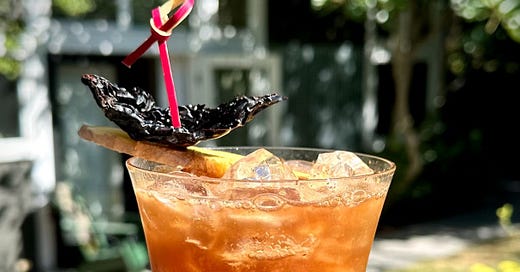



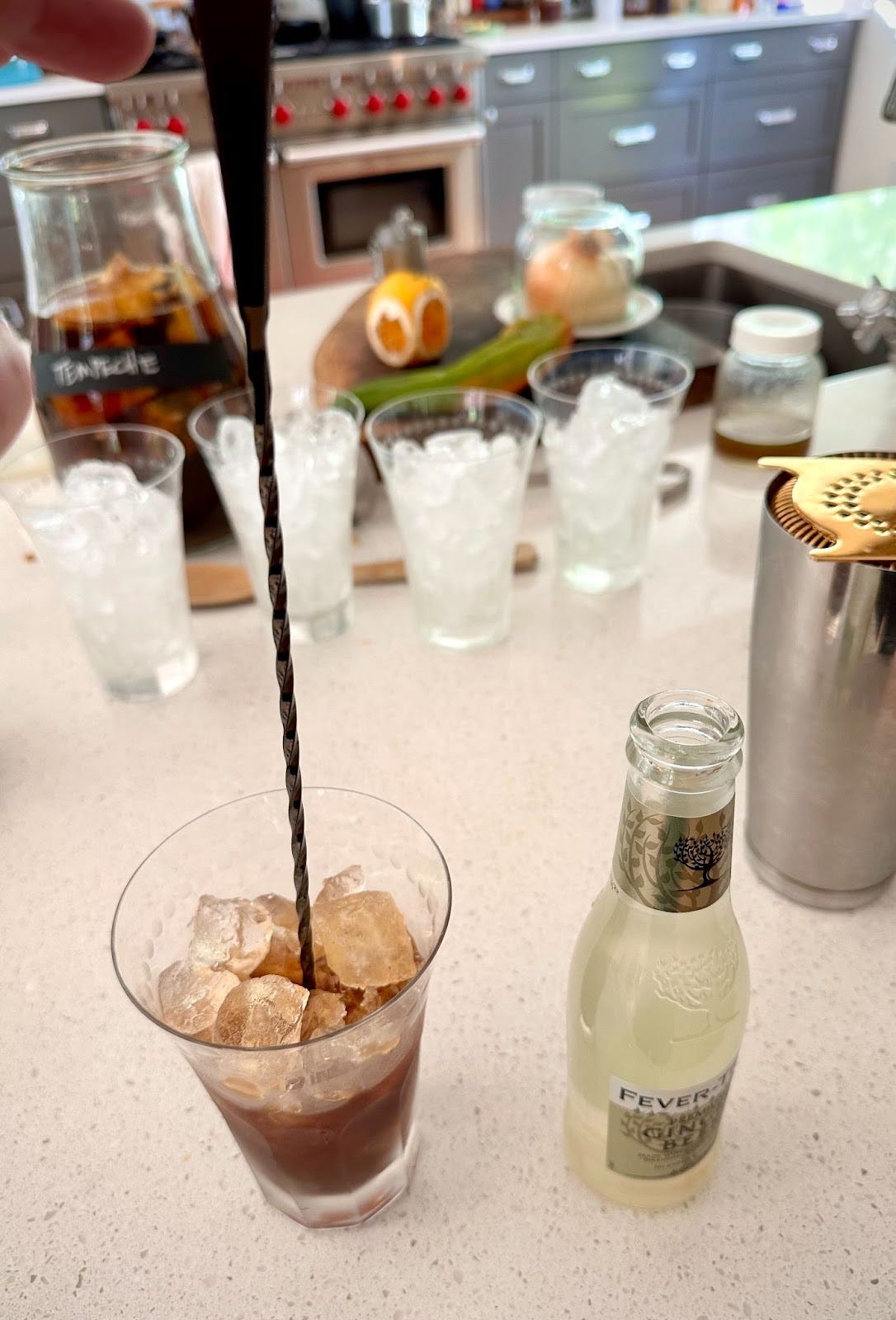
Also... love the 6 degrees of Sub Pop + KEXP additions
Nice piece on mocktails. Now counterbalance with a next installment on "shots" or "sippers."